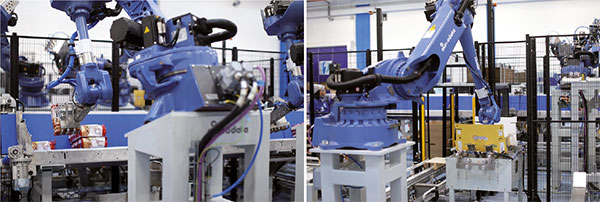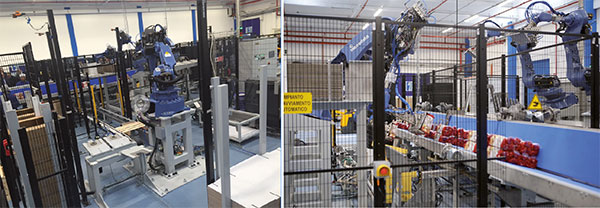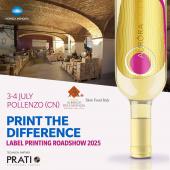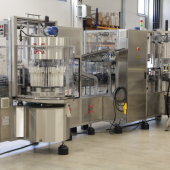Robotized co-packing
All-Italian excellence automated by Siscodata using Comau robots.
Statistics issued by the International Federation of Robotics (IFR) paint a clear picture: logistics will be one of the largest investors in robotics and automation in the coming years. This sector has been pooling its resources to reach a series of goals in which robotics has an essential role to play: operational flexibility, efficiency, “visibility” and control of work phases, the elimination of hidden costs.
According to studies, the investments will be in typical logistics applications like palletization (still fundamental to speeding end of line activities and enhancing productivity by taking some of the physical burdens off of workers), but also and especially in a series of innovative uses in packaging and handling.
An early example of such investments is the co-packing line launched in March by Number1, a leading international logistics operator specialized in the grocery sector.
Using 5 Comau robots integrated by Siscodata, the line performs complete co-packing of products placed on conveyor belts by operators. The line forms the displays that will hold them, then performs pick & place filling and final palletization.

Overview of the line created by Siscodata with 5 Comau robots.
How it works
The installation is divided into three areas: the display-forming area, the pick & place/filling island and the stacking area.
The display forming area. The display forming system enables creating two types of displays, pallet boxes and display trays. For both types, a Comau NJ40 robot forms the display by picking automatically from special silos. The robot closes the bottom using hot melt technology, breaking and refolding the middle and gluing the display onto a wood pallet, or else inserts a carton form to complete the display. During the tray forming, on the other hand, the side flaps are left open so that the products can be inserted during pick & place.
At this point the displays are ready for filling in the pick & place area, since the display forming area communicates with the filling system.
Pick & place/filling island. The pick & place island automatically arranges the products in the displays using 4 COMAU NS12 robots. The system is able to manipulate many different kinds of products, for example boxes of biscuits, flowpacks, glass jars in multipacks and many more. It can also fill a pallet with ¼ pallet boxes and ¼ pallet display trays (600 x 400 mm).
As already mentioned, the pallet boxes and trays arrive preformed and ready to fill; at this point the products are automatically picked and placed in the pallet box and/or tray by twin robots.
Furthermore, depending on the object, the system also includes at this point a buffer station for inserting honeycomb carton spacers and supports.
Empty pallet boxes and trays arriving from the forming area are automatically positioned in the filling area. Once the pick & place process is completed and the flaps have been hot melt closed, the boxes/trays are automatically readied for stacking by a pair of coordinated robot arms.
Stacking area. For the final phase, the filled packaging is stacked. The pallet boxes are already equipped with a mini-pallet or carton form during the forming phase, so that they require no additional processing during the stacking phase. The display trays, on the other hand, once filled, are accumulated at the outfeed of the pick & place area. Once the system has automatically closed the top of the trays (gluing the side flaps), they are stacked and placed on wood mini-pallets from the forming area.
The advantages
This line is able to make 40 displays each hour, a level of productivity and efficiency unreachable with other automatic or manual processes. Furthermore, it enables reassigning operators to other functions that are less physically demanding and potentially hazardous to their health. In the case of the Number1 line, the operators’ new role is to load the products onto the conveyors that transport them to the pick & place island, as well as monitoring the line’s functioning and promptly intervening whenever there are any issues. It is worth stressing that since the line was activated, no jobs have been lost. Rather, this investment in automation requires the presence of workers capable of taking care of the installed system.
The robots used on the Number1 line by the system integrator Siscodata are built by COMAU. They feature an IP67 grade of protection and are equipped with fifth generation controls (C5G), Teach Pendant TP5, touchscreen and TFT color LCD display. The C5G control features a USB port that can be used to upload new programs or download production logs. It can interface with the most common fieldbus types and exchange data with existing network PCs using an onboard Ethernet port. In such a way, for example, it is possible to send production data logs for the packing list or warehouse stocking.
|
Focus on the companies 6) Siscodata, a system integrator based in Arcisate (VA), was founded in 1974. After initially making electronic systems and heat sensors for Siemens and Philips, the company went on to specialize in the production of devices for nuclear physics labs and aeronautics. Since 1978, it has been developing electronic devices and stations for textile manufacturing applications, first in the domestic and later in the global market. It has now installed equipment in every part of the world and is a Comau Preferred System Integrator.  Comau, an FCA Group Company, is a leading global provider of advanced industrial automation solutions capable of integrating products, technologies and services, helping concerns of all sizes to enhance the production efficiency of their installations while at the same time reducing operational costs. The firm’s industrial expertise ranges from sealing to assembly, including production of complete installations, robotized production systems, powertrain processes, and a consulting service for process optimization. With its administrative center in Turin, Comau has operated for over 40 years through an extensive network of 34 branch offices, 15 production sites and 5 innovation centers, spread across 17 countries, with a total workforce of 9,000 employees. |




















